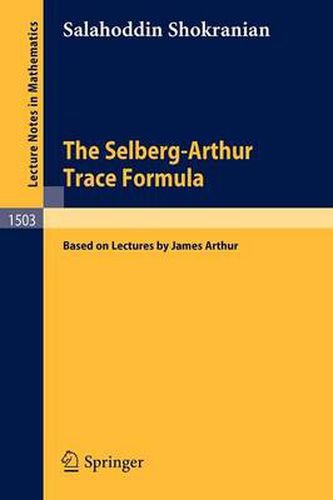Readings Newsletter
Become a Readings Member to make your shopping experience even easier.
Sign in or sign up for free!
You’re not far away from qualifying for FREE standard shipping within Australia
You’ve qualified for FREE standard shipping within Australia
The cart is loading…






This title is printed to order. This book may have been self-published. If so, we cannot guarantee the quality of the content. In the main most books will have gone through the editing process however some may not. We therefore suggest that you be aware of this before ordering this book. If in doubt check either the author or publisher’s details as we are unable to accept any returns unless they are faulty. Please contact us if you have any questions.
This book based on lectures given by James Arthur discusses the trace
formula of Selberg and Arthur. The emphasis is laid on Arthur’s trace
formula for GL®, with several examples in order to illustrate the basic
concepts. The book will be useful and stimulating reading for graduate
students in automorphic forms, analytic number theory,
and non-commutative harmonic analysis, as well as researchers in these fields. Contents: I. Number Theory and Automorphic Representations.1.1.
Some problems in classical number theory, 1.2. Modular forms
and automorphic representations; II. Selberg’s Trace Formula 2.1.
Historical Remarks, 2.2. Orbital integrals and Selberg’s trace formula, 2.3.Three examples, 2.4. A necessary condition, 2.5. Generalizations and
applications; III. Kernel Functions and the Convergence Theorem,
3.1. Preliminaries on GL®, 3.2. Combinatorics and reduction theory,
3.3. The convergence theorem; IV. The Ad lic Theory, 4.1. Basic facts; V.
The Geometric Theory, 5.1. The JTO(f) and JT(f) distributions, 5.2. A
geometric I-function, 5.3. The weight functions; VI. The Geometric Expansionof the Trace Formula, 6.1. Weighted orbital integrals, 6.2.
The unipotent distribution; VII. The Spectral Theory, 7.1. A review of the Eisenstein series, 7.2. Cusp forms, truncation, the trace formula; VIII.The Invariant Trace Formula and its Applications, 8.1. The invariant
trace formula for GL®, 8.2. Applications and remarks
$9.00 standard shipping within Australia
FREE standard shipping within Australia for orders over $100.00
Express & International shipping calculated at checkout
Stock availability can be subject to change without notice. We recommend calling the shop or contacting our online team to check availability of low stock items. Please see our Shopping Online page for more details.
This title is printed to order. This book may have been self-published. If so, we cannot guarantee the quality of the content. In the main most books will have gone through the editing process however some may not. We therefore suggest that you be aware of this before ordering this book. If in doubt check either the author or publisher’s details as we are unable to accept any returns unless they are faulty. Please contact us if you have any questions.
This book based on lectures given by James Arthur discusses the trace
formula of Selberg and Arthur. The emphasis is laid on Arthur’s trace
formula for GL®, with several examples in order to illustrate the basic
concepts. The book will be useful and stimulating reading for graduate
students in automorphic forms, analytic number theory,
and non-commutative harmonic analysis, as well as researchers in these fields. Contents: I. Number Theory and Automorphic Representations.1.1.
Some problems in classical number theory, 1.2. Modular forms
and automorphic representations; II. Selberg’s Trace Formula 2.1.
Historical Remarks, 2.2. Orbital integrals and Selberg’s trace formula, 2.3.Three examples, 2.4. A necessary condition, 2.5. Generalizations and
applications; III. Kernel Functions and the Convergence Theorem,
3.1. Preliminaries on GL®, 3.2. Combinatorics and reduction theory,
3.3. The convergence theorem; IV. The Ad lic Theory, 4.1. Basic facts; V.
The Geometric Theory, 5.1. The JTO(f) and JT(f) distributions, 5.2. A
geometric I-function, 5.3. The weight functions; VI. The Geometric Expansionof the Trace Formula, 6.1. Weighted orbital integrals, 6.2.
The unipotent distribution; VII. The Spectral Theory, 7.1. A review of the Eisenstein series, 7.2. Cusp forms, truncation, the trace formula; VIII.The Invariant Trace Formula and its Applications, 8.1. The invariant
trace formula for GL®, 8.2. Applications and remarks